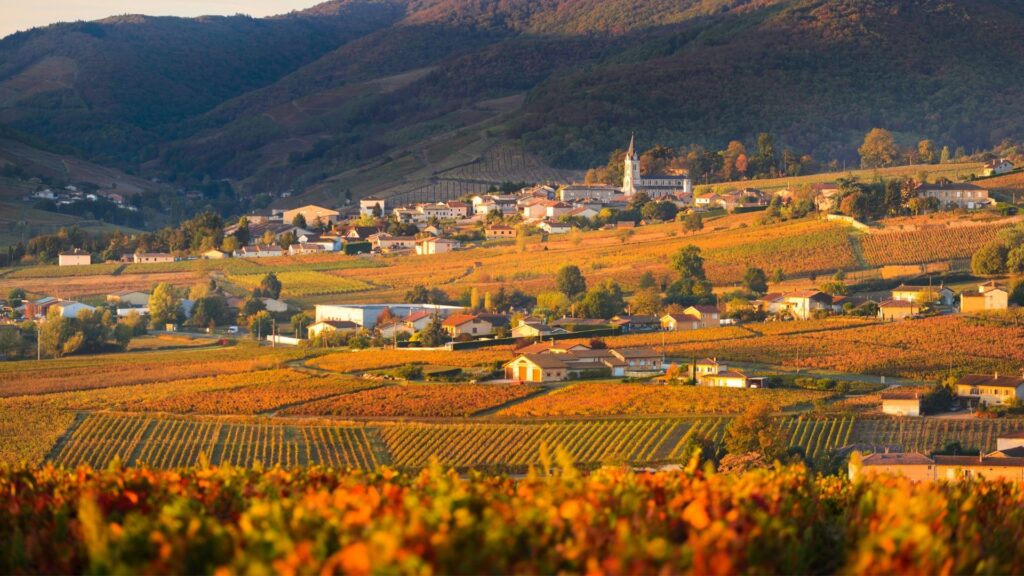DiVino may earn commissions from qualifying purchases.
The what, where, and wonderful world of Beaujolais wines
While Beaujolais is geographically the southernmost wine-producing region of Burgundy, it is generally considered a region of its own for a number of reasons. The climate and terrain has much more in common with the Rhône region, and the main grape is Gamay, as opposed to Pinot Noir or Chardonnay.
The history of winemaking in Beaujolais shares similar origins with the rest of Burgundy, starting with Roman civilization the Catholic Church, but things took a turn during the Middle Ages. Compared to Pinot Noir, Gamay ripens earlier, is easier to cultivate ad extremely prolific. Despite local success of the grape variety throughout the region, a Burgundian Duke outlawed the planting and production of Gamay-based wines in the North in favor of more “elegant” and commercially viable Pinot Noir, asnd thus, Gamay moved and found a welcoming granite-rich soil and warmer climate.
Beaujolais has since regained its reputation not only for large scale production – Beaujolais produces far more wine than the rest of Burgundy—but also for quality. Northern Beaujolais is steeper, cooler, and has a blend of soil types, including larger quantities of granite and schist. This is where you find the top Beaujolais Crus. Wines are full-bodied and sleek, with distinctive character, aromatic complexity spanning deep fruit and earthy, smoky notes, and a potential to age. The south is warmer, flatter and sandier. Wines are rounder, fruiter, and easy to drink with all kinds of foods.
While much of the world has come to know Beaujolais for the light-bodied, fruit-forward Beaujolais Nouveau wines, but true connoisseurs and collectors alike have realized the potential of Beaujolais to produce exceptional wines.
Main Beaujolais Grape Varieties
Gamay, Aligoté, Chardonnay.
Beaujolais Wine Classification
Beaujolais appellations (AOCS) and classifications were established along with most of France in 1936, and have since evolved slightly to account for distinctive crus and quality.
- AOC Beaujolais and Beaujolais Supérior can be produced throughout the region. Supérior refers to riper, grapes and higher minimum ABV, which would denote a slightly fuller and more elegant body. These generally considered easy-to-drink, everyday wines.
- AOC Beaujolais Blanc and Rosé exist, largely in the North, and whre possible, growers align themselves with a Burgundy Villages AOC.
- AOC Beaujolais-Villages AOC, like the rest of Burgundy is specific to growing areas surrounding said village. Most them are red and also meant to be enjoyed relatively young. There 39 currently, some of which coincide with more prestigious AOC Burgundy Villages, like Macon-Village, and produce white wines. Find one online.
- Cru Beaujolais carry the appellation (AOC) of the cru vineyard where the grapes originate. They are all located in the North. These are the top-tier Beaujolais wines, all almost exclusively made from Gamay. Some of them age longer than others, and range fruit-forward to bold and spicy. They are all considered exceptional expressions of the Gamay grape.
Beaujolais Crus to Recognize
- Brouilly – The largest cru that also allows white grapes like Aligoté and Chardonnay.
- Côte de Brouilly – Located within the Brouilly designated growing area, on the slopes of an extinct volcano, which adds complexity to the soil and depth to the wine.
- Chiroubles – High slopes, and more delicate floral aromas.
- Régnié – Full and fruity, it’s rich but meant to enjoy relatively young. Find one online.
- Fleurie – Complex, floral, and built for aging. Cru Fleurie can develop a luxurious satiny texture over the years while maintaining immense freshness. If Chénas , Morgon, and Moulin-à-Vent are the king Crus, Fleurie is the queen. Find one online.
- Saint-Amour – Fruity and spicy, these wine ages and evolve over many years.
- Chénas – The smalled cru, these wines can take some time to relax and release their aromas, but when they do, they offer earthy notes of wood and bark or flowers like violet and rose. Find one online.
- Juliénas – Known for sweet spices, and peppery fruit.
- Moulin-à-Vent – Like Chénas, these are meant to rest in the cellar for 5-20 years before releasing a full spectrum of body, fruit, spices, smoke, and flowers.
- Morgon – The second-largest cru, it contains several smaller climats within it, and thus a great variety. Generally speaking, Morgon fleshy and fruity in its youth, and earthy, complex, and elegant with age. It is often compared to late stage Burgundian Pinot Noir. Find one online.
Beaujolais Nouveau
Literally, ‘new wine’, Beaujolais Nouveau was traditionally bottled and distributed immediately out of the cellar in part to celebrate a successful harvest but also recuperate costs as soon as possible. It’s expressly light, fruity, and best served slightly chilled.
Carbonic Maceration
Beaujolais is also known for widely utilized practice known as carbonic maceration, in which whole grape clusters are placed into stainless steel, or more traditionally in cement tanks. The weight of the grapes on top crushes those on the bottom, and fermentation begins naturally and with very little oxygen. This type of maceration and fermentation yields very light, fruity, and low tannin wines in the first week or so. AOC wines of higher quality macerate longer and develop deeper color, a fuller structure, and far more aromatic complexity.

Le Beaujolais Nouveau Est Arrivé!
The first mention of Beaujolais for most of us was probably Beaujolais Nouveau, which like rosé season in the United States is primarily due to stellar marketing. There is now a national Beaujolais Day on the third Thursday of November, and restaurants throughout the region, France, and the world post colorful signs proclaiming “Le Beaujolais nouveau est arrivé!”
Find one online.
The Beaujolais Takeaway
Beaujolais is geographically part of Burgundy, but a standalone wine region for style, terroir, and tradition. The main grape is Gamay, and the most sought-after bottles come from 10 cru growing areas.
Beaujolais is known for light-bodied, fruity wines like Beaujolais Nouveau, but these do not encapsulate the quality and diversity of Gamay-based Beaujolais.



